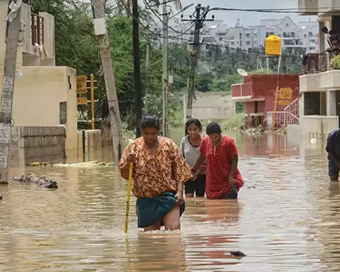 PM Modi visit USA
PM Modi visit USA Only the mirror in my washroom and phone gallery see the crazy me : Sara Khan
Only the mirror in my washroom and phone gallery see the crazy me : Sara Khan Karnataka rain fury: Photos of flooded streets, uprooted trees
Karnataka rain fury: Photos of flooded streets, uprooted trees Cannes 2022: Deepika Padukone stuns at the French Riviera in Sabyasachi outfit
Cannes 2022: Deepika Padukone stuns at the French Riviera in Sabyasachi outfit Ranbir Kapoor And Alia Bhatt's Wedding Pics - Sealed With A Kiss
Ranbir Kapoor And Alia Bhatt's Wedding Pics - Sealed With A Kiss Oscars 2022: Every Academy Award Winner
Oscars 2022: Every Academy Award Winner Shane Warne (1969-2022): Australian cricket legend's life in pictures
Shane Warne (1969-2022): Australian cricket legend's life in pictures Photos: What Russia's invasion of Ukraine looks like on the ground
Photos: What Russia's invasion of Ukraine looks like on the ground Lata Mangeshkar (1929-2022): A pictorial tribute to the 'Nightingale of India'
Lata Mangeshkar (1929-2022): A pictorial tribute to the 'Nightingale of India' PM Modi unveils 216-feet tall Statue of Equality in Hyderabad (PHOTOS)
PM Modi unveils 216-feet tall Statue of Equality in Hyderabad (PHOTOS)Hockey India has announced a 54-member core probable squad for the upcoming senior men’s
- Satwik-Chirag return as BAI names 14-strong squad for BWF Sudirman Cup Finals 2025
- Men’s Sr Hockey Nationals to be played in division-based format from April 4
- Mensik denies Djokovic 100th title in Miami final
- KIPG: Son of a vegetable vendor, Bihar’s Jhandu Kumar eyes Worlds, 2028 Paralympics
- Hardik Singh credits hard work and team unity for receiving HI Midfielder of the Year award
Polio vaccines produced without growth of live virus Last Updated : 02 Feb 2017 02:04:35 PM IST 
(File Photo)
Scientists have identified new ways to provide vaccines against polio which do not require the growth of live virus for their manufacture, thereby reducing risk of virus escaping into the environment.
Polio is on the verge of being eradicated world-wide, but even when it has been officially declared as extinct as a disease, governments will need to continue to vaccinate to ensure against it recurring.
Using current technology, the production of vaccine requires the growth of enormous quantities of live virus, which is then chemically killed, thus presenting a dangerous security risk of virus escaping into the environment.
"Continuing to vaccinate after polio has been eradicated is essential to ensure against the disease recurring, but there are significant biosafety concerns about current production methods," said co-leader of the study David Rowlands, Professor of Molecular Virology at University of Leeds in Britain.
"Our new method of creating the vaccine has been proven to work in lab conditions and on top of that we've proved it's actually more stable than existing vaccines," Rowlands said.
Despite the success of vaccines produced from 'virus-like particles' (VLPs) for hepatitis B and human papilloma viruses, poliovirus VLPs have proved to be too unstable to make practical vaccines.
The research team found a new way to modify these VLPs, also known as 'empty capsids' by identifying mutations which make their structures sufficiently stable to act as vaccines.
The empty capsids change shape when warmed and become unusable as vaccines, but the mutations identified in this research prevent these damaging changes.
These new stabilised VLPs are suitable as replacements for the current killed poliovirus vaccines and can be produced in ways that do not require the growth of live virus, said the study published in the Journal of Virology.
Using the newly developed stabilised VLPs would be best used after the virus has been eradicated, the researchers said.
This study was a lab experiment, which shows stabilised VLPs to be effective in a controlled environment.
Further research using animals (rats and mice) is planned, as part of the essential process of making sure the new VLPs are safe and effective for use in humans, the researchers said.IANS For Latest Updates Please-
Join us on
Follow us on








172.31.16.186







